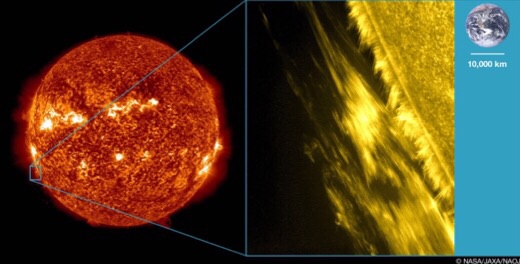ATERUI solves Sun's coronal heating problem

Solar physicists have captured the first direct observational signatures of resonant absorption, thought to play an important role in solving the “coronal heating problem” which has defied explanation for over 70 years.
An international research team from Japan, the U.S.A., and Europe led by Drs. Joten Okamoto and Patrick Antolin combined high resolution observations from JAXA’s Hinode mission and NASA’s IRIS (Interface Region Imaging Spectrograph) mission, together with state-of-the-art numerical simulations and modeling from NAOJ’s ATERUI supercomputer. In the combined data, they were able to detect and identify the observational signatures of resonant absorption.
Resonant absorption is a process where two different types of magnetically driven waves resonate, strengthening one of them. In particular this research looked at a type of magnetic waves known as Alfvénic waves which can propagate through a prominence (a filamentary structure of cool, dense gas floating in the corona). Here, for the first time, researchers were able to directly observe resonant absorption between transverse waves and torsional waves, leading to a turbulent flow which heats the prominence. Hinode observed the transverse motion and IRIS observed the torsional motion; these results would not have been possible without both satellites.
This new information can help explain how the solar corona reaches temperatures of 1,000,000 degrees Celsius; the so called “coronal heating problem.”
The scientific paper on which this article is based appears in the Astrophysical Journal.
Journal References:
- P. Antolin, T. J. Okamoto, B. De Pontieu, H. Uitenbroek, T. Van Doorsselaere, T. Yokoyama. RESONANT ABSORPTION OF TRANSVERSE OSCILLATIONS AND ASSOCIATED HEATING IN A SOLAR PROMINENCE. II. NUMERICAL ASPECTS. The Astrophysical Journal, 2015; 809 (1): 72 DOI: 10.1088/0004-637X/809/1/72
- Takenori J. Okamoto, Patrick Antolin, Bart De Pontieu, Han Uitenbroek, Tom Van Doorsselaere, Takaaki Yokoyama. RESONANT ABSORPTION OF TRANSVERSE OSCILLATIONS AND ASSOCIATED HEATING IN A SOLAR PROMINENCE. I. OBSERVATIONAL ASPECTS. The Astrophysical Journal, 2015; 809 (1): 71 DOI: 10.1088/0004-637X/809/1/71

 How to resolve AdBlock issue?
How to resolve AdBlock issue?